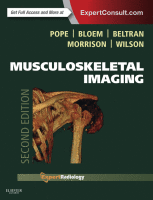Physical Address
304 North Cardinal St.
Dorchester Center, MA 02124

Introduction Routine radiography, ultrasound, CT, and MR imaging (conventional and arthrography) are the main diagnostic modalities used for diagnosis of abnormalities around the elbow joint. Conventional Radiography Radiography ( Fig. 10-1 ) is used for primary evaluation of any osseous…

Prevalence, Epidemiology, and Definitions Shoulder instability and labral tears are a common cause of shoulder complaints, particularly in young athletic individuals. The symptoms can be quite debilitating, and surgery is often required to reduce the pain or stabilize the shoulder.…

Prevalence, Epidemiology, and Definitions The etiology of rotator cuff tendinosis and tears is likely multifactorial, involving both intrinsic and extrinsic factors. Multiple causal factors have been described in association with rotator cuff pathology, including vascular, degenerative, traumatic, and anatomic/mechanical factors.…

Prevalence, Epidemiology, and Definitions Osseous injuries that affect the shoulder girdle are common in adults. The acromioclavicular joint is the primary connection between the arm and the thorax, and the glenohumeral joint is inherently unstable, owing to the disproportionate size…

Imaging Modalities and Technical Aspects Conventional radiography of the shoulder ( Table 6-1 , Fig. 6-1 ) is recommended for any primary evaluation of suspected pathology, including fractures, dislocations, bone tumors, and infection. It is readily available, inexpensive, and uses…

Prevalence, Epidemiology, and Definitions Injuries of the thoracic cage and the thoracolumbar spine are common—not only in patients with severe traumatic injuries following motor vehicle accidents (MVAs) or, for example, those who fall from great heights, but also in daily…

The exclusion of cervical spine injuries in patients with blunt trauma is one of the major challenges facing traumatologists and emergency department physicians. This is especially daunting in unresponsive or comatose patients. “Clearing” the cervical spine is a complex interdisciplinary…

The craniofacial structures have the formidable task of protecting the brain, the soft tissues that form the upper aerodigestive tracts, and the tissues vital to the special senses of vision, smell, taste, and hearing. Injury to the craniofacial region may…

In this chapter, concepts are identified and described that are intrinsic to musculoskeletal trauma, such as the purpose of the imaging report, vector forces causing musculoskeletal injury, musculoskeletal injury terminology, and fractures and dislocations in which the associated soft tissue…

Conventional Radiography The most frequently used modality for evaluation of bone and joint disorders is radiography. Radiography is the initial modality used in the setting of trauma, infection, and arthritis. It is useful for characterizing benign and malignant bone lesions…